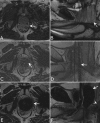Percutaneous MR-guided whole-gland prostate cancer cryoablation: safety considerations and oncologic results in 30 consecutive patients
- PMID: 30845821
- PMCID: PMC6580912
- DOI: 10.1259/bjr.20180965
Percutaneous MR-guided whole-gland prostate cancer cryoablation: safety considerations and oncologic results in 30 consecutive patients
Abstract
Objective: To assess the safety and oncological efficacy of percutaneous MR-guided whole-gland prostate cancer (PCa) cryoablation (CA).
Methods and materials: Between July 2009 and January 2018, 30 patients (mean age 72.9 ± 5.13 years) with histologically proven, organ-confined (≤ T2cN0M0), predominantly low/intermediate-risk PCa (median Gleason score 7; mean prostate specific antigen 6.05 ± 3.74 ng ml-1 ) underwent MR-guided whole-gland CA. Patients were selected on the basis of prior pelvic radiotherapy (n = 16; 12 for previous PCa), or contra indication/refusal of surgery or radiotherapy. Complications, local progression-free survival (LPFS) and overall survival (OS) were retrospectively investigated.
Results: Eighteen [60%] patients reported procedure-related complications: 5/18 [28%] needed surgical/interventional treatments and 13 [72%] conservative or pharmacological treatment. Eleven [73%] complications were noted in the first 15 patients and 7 [47%] in the last 15 patients (p = 0.26). Mean nadir prostate specific antigen was 0.24 ± 1.5 ng ml-1 (mean follow-up 3.8 years; range: 2 - 2915 days). Seven [23%] patients developed histologically proven local progression (mean time to recurrence 775 days, range: 172 - 2014). Mean clinical follow-up was 3.8 years (range 1-2915 days). LPFS was 92.0, 75.7 and 69.4 % at 1-, 3- and 5 year follow-up, respectively. For patients in salvage treatment, LPFS was 100%, 75%, and 75% at 1-, 3- and 5 year follow-up. OS was 100%, 94.4 and 88.5 % at 1-, 3- and 5 year follow-up respectively, with no patients dying from PCa.
Conclusion: Whole-gland PCa CA offers good oncological efficacy, particularly in post-radiotherapy cases. Although the complication rate is significant, the majority is minor and is managed with conservative or pharmacologic management.
Advances in knowledge: MRI-guided whole-gland prostate cancer cryoablation offers good oncological efficacy, particularly in post-radiotherapy cases with a contained complication rate.
Figures






Similar articles
-
Primary Whole-gland Cryoablation for Prostate Cancer: Biochemical Failure and Clinical Recurrence at 5.6 Years of Follow-up.Eur Urol. 2019 Feb;75(2):208-214. doi: 10.1016/j.eururo.2018.09.004. Epub 2018 Sep 28. Eur Urol. 2019. PMID: 30274702 Free PMC article.
-
Five-Year Biochemical Progression-Free Survival Following Salvage Whole-Gland Prostate Cryoablation: Defining Success with Nadir Prostate-Specific Antigen.J Endourol. 2016 Jun;30(6):624-31. doi: 10.1089/end.2015.0719. Epub 2016 Apr 5. J Endourol. 2016. PMID: 26915721
-
Percutaneous MR-guided focal cryoablation for recurrent prostate cancer following radiation therapy: retrospective analysis of iceball margins and outcomes.Eur Radiol. 2017 Nov;27(11):4828-4836. doi: 10.1007/s00330-017-4833-9. Epub 2017 Apr 13. Eur Radiol. 2017. PMID: 28409355 Free PMC article.
-
Salvage cryotherapy for radiation-recurrent prostate cancer: outcomes and complications.Curr Urol Rep. 2011 Jun;12(3):209-15. doi: 10.1007/s11934-011-0182-4. Curr Urol Rep. 2011. PMID: 21394596 Free PMC article. Review.
-
Salvage cryoablation for locally recurrent prostate cancer following primary radiotherapy.Eur Urol. 2012 Jun;61(6):1204-11. doi: 10.1016/j.eururo.2012.02.051. Epub 2012 Mar 8. Eur Urol. 2012. PMID: 22421081 Review.
Cited by
-
Intratumoural immunotherapy plus focal thermal ablation for localized prostate cancer.Nat Rev Urol. 2024 May;21(5):290-302. doi: 10.1038/s41585-023-00834-y. Epub 2023 Dec 19. Nat Rev Urol. 2024. PMID: 38114768 Review.
-
Recent progress in cryoablation cancer therapy and nanoparticles mediated cryoablation.Theranostics. 2022 Feb 14;12(5):2175-2204. doi: 10.7150/thno.67530. eCollection 2022. Theranostics. 2022. PMID: 35265206 Free PMC article. Review.
-
Image-Guided Prostate Cryoablation: State-of-the-Art.Medicina (Kaunas). 2023 Sep 2;59(9):1589. doi: 10.3390/medicina59091589. Medicina (Kaunas). 2023. PMID: 37763708 Free PMC article. Review.
-
Percutaneous MR-guided prostate cancer cryoablation technical updates and literature review.BJR Open. 2019 Jun 3;1(1):20180043. doi: 10.1259/bjro.20180043. eCollection 2019. BJR Open. 2019. PMID: 33178928 Free PMC article. Review.
-
Advances in Image-Guided Ablation Therapies for Solid Tumors.Cancers (Basel). 2024 Jul 17;16(14):2560. doi: 10.3390/cancers16142560. Cancers (Basel). 2024. PMID: 39061199 Free PMC article. Review.
References
-
- Siegel RL , Miller KD , Jemal A , Statistics C . Ca: a cancer journal for clinicians . 2017. ; 67 : 7 – 30 . - PubMed
-
- Graham J , Baker M , Macbeth F , Titshall V , . Guideline Development Group . Diagnosis and treatment of prostate cancer: summary of NICE guidance . BMJ 2008. ; 336 : 610 – 2 . doi: 10.1136/bmj.39498.525706.AD - DOI - PMC - PubMed
MeSH terms
Substances
LinkOut - more resources
Full Text Sources
Medical

